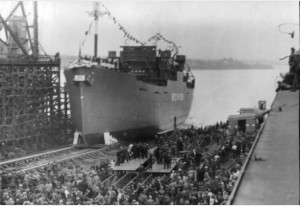8.8 The Shipping Industry in Canada, 1867 – 1945
Eric W. Sager, Department of History, University of Victoria

Canada has the longest coastline of any country in the world, and a large overseas trade. However, for more than 50 years, the country has not had a large merchant marine. Why this apparent paradox? For much of the 19th century, the colonies and the Dominion of Canada had relatively large shipping and shipbuilding industries. By the 1870s, the official statistics suggest that Canada had the fourth largest domestically-registered merchant marine in the world. Most of the tonnage consisted of wooden-hulled sailing ships, most of which were registered in the Maritime provinces and Quebec. The shipping industry had developed in large part to transport bulk commodities — mainly timber and wheat — from the colonies to Britain. By the third quarter of the 19th century, Canadian ships were deeply committed to the transport of bulk cargoes from the eastern United States to Britain and Europe.
Older history books have a simple explanation for the decline of the shipping and shipbuilding industries after the 1880s. Wooden-hulled sailing ships became obsolete; therefore the industry declined. This explanation is no longer acceptable, since it is considered technological determinism. Canadian shipowners operated iron steamships, and Canada had the resources to build iron and steel ships. Some Canadian shipowners, such as Hugh Allan, established liner companies that operated in the North Atlantic. Yet, shipping experienced a relative decline because capitalists perceived better investment opportunities elsewhere in Canada; because governments did not offer much support or protection for shipping; and because cheap shipping services were increasingly available from other countries.
During the two world wars, Canada renewed its involvement in shipping and shipbuilding. In 1918 the federal government created the Canadian Government Merchant Marine (CGMM), which operated merchant ships for several years at a time when the war had caused a decline in available tonnage. During the Second World War, another government-owned company, Park Steamships Limited, made a vital contribution to wartime trade with Britain. After the war, the deep-sea merchant marine declined, and by the 1970s, few Canadian flag ships operated in ocean trades.
Key Points
- Canadian and Newfoundland shipping was a powerful and internationally credible sector of the economy in the late 19th century.
- Built to handle bulk goods, Canadian shipping played an important role in transporting goods between the United States and Europe.
- Although historians disagree over the causes of the decline of the Canadian shipping sector, the former emphasis on technological change has given way to a movement of capital out of shipping into other investments.
Additional Readings
Heal, Syd C. A Great Fleet of Ships: The Canadian Forts and Parks. Ontario: Vanwell Publishing, 1999.
Sager, Eric W. and Gerald Panting. Maritime Capital: The Shipping Industry in Atlantic Canada, 1820-1914. Montreal and Kingston: McGill-Queen’s University Press, 1990.
Sager, Eric W. Seafaring Labour: The Merchant Marine of Atlantic Canada, 1820-1914. Montreal and Kingston: McGill-Queen’s University Press, 1989.
Attributions
Figure 8.12
Ssashbypark1944 by Maggil07 is in the public domain.

